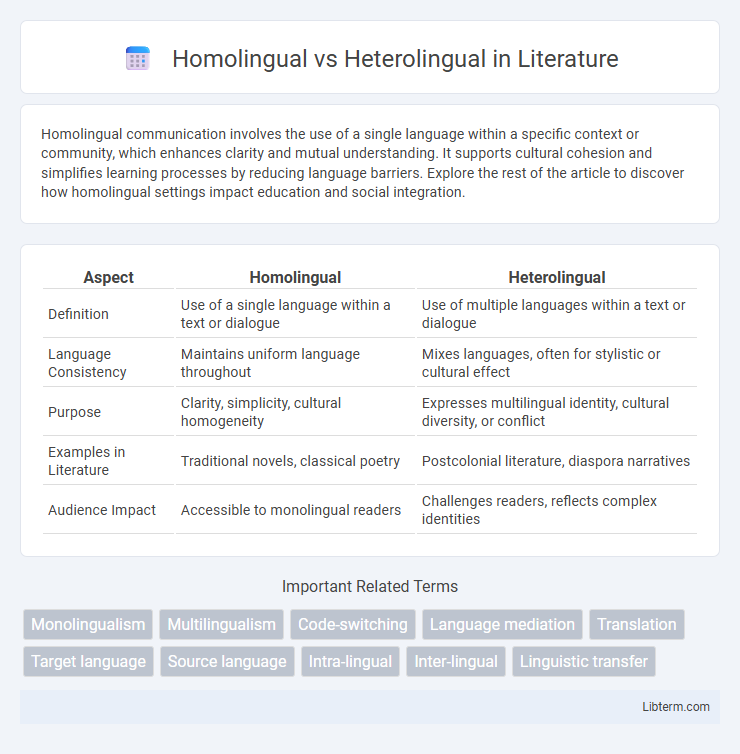Homolingual communication involves the use of a single language within a specific context or community, which enhances clarity and mutual understanding. It supports cultural cohesion and simplifies learning processes by reducing language barriers. Explore the rest of the article to discover how homolingual settings impact education and social integration.
Table of Comparison
| Aspect | Homolingual | Heterolingual |
|---|---|---|
| Definition | Use of a single language within a text or dialogue | Use of multiple languages within a text or dialogue |
| Language Consistency | Maintains uniform language throughout | Mixes languages, often for stylistic or cultural effect |
| Purpose | Clarity, simplicity, cultural homogeneity | Expresses multilingual identity, cultural diversity, or conflict |
| Examples in Literature | Traditional novels, classical poetry | Postcolonial literature, diaspora narratives |
| Audience Impact | Accessible to monolingual readers | Challenges readers, reflects complex identities |
Understanding Homolingual and Heterolingual Communication
Understanding homolingual communication involves interactions between speakers sharing the same language, facilitating clear and efficient exchange of ideas without translation barriers. Heterolingual communication occurs when speakers use different languages, requiring strategies such as code-switching, translation, or linguistic accommodation to bridge meaning. Recognizing these modes enhances multilingual settings by improving comprehension, reducing misunderstandings, and fostering effective dialogue across language boundaries.
Key Differences Between Homolingual and Heterolingual Contexts
Homolingual contexts involve communication within a single language, promoting linguistic uniformity and clearer mutual understanding among speakers. Heterolingual contexts encompass multiple languages or language varieties, resulting in complex interactions influenced by code-switching, translation, and cultural diversity. Key differences include the degree of language mixing, cognitive load on speakers, and the sociolinguistic dynamics governing communication practices.
Historical Perspectives on Language Use
Historical perspectives on language use reveal that homolingual societies often prioritized linguistic uniformity to reinforce cultural identity and social cohesion, as seen in nation-states like Japan and France. In contrast, heterolingual societies, such as the Ottoman Empire and colonial India, fostered multilingualism to facilitate trade, administration, and intercultural communication. These differing approaches highlight how language policies shaped power dynamics and cultural exchange throughout history.
Sociolinguistic Implications of Homolingualism
Homolingualism, characterized by the exclusive use of one language within a community, often fosters strong cultural identity and social cohesion by reinforcing shared linguistic norms and traditions. It can limit exposure to linguistic diversity, potentially leading to reduced intercultural communication skills and resistance to multilingual policies in education and governance. Sociolinguistically, homolingualism may contribute to the marginalization of minority languages, affecting language maintenance and cultural heritage preservation in multicultural societies.
Challenges in Heterolingual Interactions
Heterolingual interactions often face communication barriers due to diverse language structures and cultural nuances that complicate mutual understanding. Misinterpretations and loss of meaning are common because participants may lack proficiency in each other's languages, leading to increased cognitive load and social discomfort. Effective strategies require adaptive language skills and intercultural competence to bridge linguistic gaps and facilitate accurate, meaningful exchanges.
Language Identity and Cultural Exchange
Homolingual communities maintain a strong language identity by preserving a single dominant language, which reinforces cultural cohesion and shared heritage. Heterolingual settings promote cultural exchange through multilingualism, allowing individuals to navigate and integrate multiple linguistic identities. This dynamic fosters greater intercultural understanding, enriching both personal identity and collective cultural experiences.
Educational Approaches: Monolingual vs Multilingual Classrooms
Monolingual classrooms, characterized by a homolingual approach, focus exclusively on a single language, promoting deep proficiency but limiting exposure to linguistic diversity. Heterolingual or multilingual classrooms embrace multiple languages simultaneously, encouraging cognitive flexibility, cultural awareness, and enhanced problem-solving skills in students. Educational strategies in multilingual environments integrate language acquisition with content learning, fostering inclusive participation and real-world communication competencies.
Media Representation of Homolingual and Heterolingual Practices
Media representation of homolingual practices often highlights linguistic uniformity and cultural cohesion, portraying characters who communicate exclusively within a single language community. In contrast, heterolingual media representations emphasize code-switching, multilingual interactions, and the fluid negotiation of identity across diverse linguistic landscapes. Such portrayals reflect the dynamic realities of globalization and migration, challenging monolingual norms by showcasing hybrid language usage in everyday communication.
The Impact of Globalization on Language Diversity
Globalization accelerates the spread of dominant languages, often leading to homolingual environments where a single language prevails, diminishing linguistic diversity. Heterolingual contexts, characterized by multiple coexisting languages, face challenges as global languages like English reduce the use and transmission of minority languages. The resulting language shift impacts cultural identity and heritage, making the preservation of heterolingual societies crucial for maintaining global linguistic diversity.
Future Trends in Language Interaction
Future trends in language interaction increasingly emphasize heterolingual communication, driven by globalization and digital media platforms fostering multilingual exchanges. Advanced natural language processing and AI translation tools are enhancing seamless interactions across diverse languages, reducing barriers in real-time communication. Homolingual environments may diminish as adaptive technologies prioritize fluid, cross-linguistic understanding in education, business, and social networks.
Homolingual Infographic

 libterm.com
libterm.com